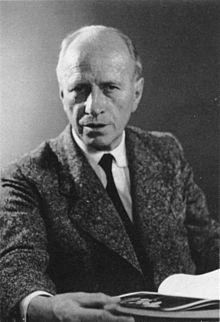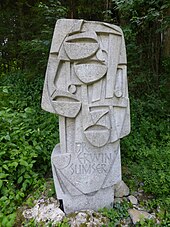Erwin Sumser
Erwin Sumser (born October 8, 1891 in Merzhausen near Freiburg im Breisgau as Erwin Josef Sumser ; † January 22, 1961 in Hüfingen ) was a German doctor and pioneer of nature conservation .
Life
The ancestors came from the Hexental , which stretches from Merzhausen via Au to the south. The father, Joseph Martin Sumser, ran a farm in Merzhausen. The two grandfathers were mayors in Au and Merzhausen. After studying medicine in Freiburg, after obtaining a doctorate as a Dr. med. and four years of military service in the First World War , Erwin Sumser took over a country doctor's practice in Hüfingen in 1920, with responsibility also for twelve surrounding communities, as well as the care of the Hüfingen Hospital and the Fürstlich Fürstenbergisches Landesspital in Hüfingen. In 1928 he married Auguste Margarete Petrus from Düsseldorf, with whom he had three children. After she died in 1934, he married Margaretha Julie Schropp from Hüfingen in 1936. The marriage had four more children. Sick at the beginning of the Second World War , Sumser was employed as a senior staff doctor in the Donaueschingen military hospital . In this function he saved some wounded soldiers from being deployed back to the front. Confronted with euthanasia campaigns by the National Socialists in the State Hospital in Hüfingen , he rescued disabled people as far as possible. As a doctor, he also looked after and protected the parents of Hans and Sophie Scholl , the members of the White Rose resistance group who were executed in 1943 and who had withdrawn to the area of his country doctor's practice in the upper Wutach Valley.
Sumer's most famous patient (if only for a consultation) was the philosopher Martin Heidegger . Heidegger's sister Marie was married in Hüfingen, so he often stayed here to visit. Martin Heidegger needed medical help in one of these in February 1945. In a letter to his wife Elfriede on February 2, 1945, he wrote:
"I didn't feel particularly well on the night drive here - another day I went to Marie's local doctor, who tried very hard and said that mental overexertion caused the symptoms. I should rest for a while." (from "My dear soul", Martin Heidegger's letters to his wife Elfriede, p. 231).
natural reserve
Sumser saw the endangerment of plants, especially orchids, early on on Schönberg near Merzhausen and then in the Baar near Hüfingen. Protecting them became his second mission in life. Since December 1931 he bought or leased floristically valuable plots, first in the Jennetal on the Ebringer district on Schönberg, then on the Baar. He fenced them in and prevented their agricultural use. He also paid compensations to farmers if they left their land in its original state, gave slide shows and solicited fellow campaigners. With like-minded people he prevented the project to stow the Wutach , which would have meant the end of the Wutach Gorge . He advised Hüfinger on their traditional flower carpets on Corpus Christi . In 1960 he sold the nature reserves he had bought to the state of Baden-Württemberg.
Sumsergarten
He had the areas he bought with an area of 7100 m 2 near Ebringen fenced in to protect them. They were then named Sumsergarten , are still fenced in today and form a core area of the Jennetal nature reserve .
Honor
A memorial stone on a path from Hüfingen to Bräunlingen , depicting stylized lady 's slipper flowers, bears the inscription: “Dr. Erwin Sumser - 40 years doctor in Hüfingen. His life was blessed in his work for the sick and for the flowers of his homeland. "
Individual evidence
- ↑ Benno Kuhn: Why the Jennetal nature reserve is also called Sumsergarten. In: Ebringer Dorfgeschichten 2007, No. 1: 1–8
- ↑ Martin Heidegger: "My dear soul!" Martin Heidegger's letters to his wife Elfriede 1915-1970 . Ed .: Gertrud Heidegger. Munich, ISBN 978-3-442-73732-1 .
- ↑ Manfred Beat Halter: Donaueschingen: Remembering Erwin Sumser. suedkurier.de, January 22, 2011, accessed on January 10, 2016 .
| personal data | |
|---|---|
| SURNAME | Sumser, Erwin |
| BRIEF DESCRIPTION | German doctor |
| DATE OF BIRTH | October 8, 1891 |
| PLACE OF BIRTH | Merzhausen |
| DATE OF DEATH | January 22, 1961 |
| Place of death | Hüfingen |


